Photopropism is because of unequal distribution of auxin under the influence of unilateral (one sided) illumination as auxin
Moves from illuminated side to shaded side
Synthesis is checked on illuminated side
Destroyed on illuminated and not on shaded side
All of the above.
The correct Answer is:D
Step-by-Step Solution:
1. Understanding Phototropism:
- Phototropism is the growth response of a plant towards light. The term "photo" refers to light, and "tropism" refers to a growth response.
2. Role of Auxin:
- Auxin is a plant hormone that regulates growth. It is responsible for the elongation of cells on the side of the plant that is away from the light source.
3. Unequal Distribution of Auxin:
- When light is shining on one side of the plant (unilateral illumination), auxin is distributed unevenly. It accumulates more on the shaded side of the plant.
4. Growth Response:
- The higher concentration of auxin on the shaded side causes those cells to elongate more than the cells on the illuminated side. This differential growth causes the plant to bend towards the light.
5. Analyzing the Options:
- Option 1: "Moves from illuminated side to the shaded side" - This is correct because auxin moves towards the shaded side.
- Option 2: "Synthesis is checked on illuminated side" - This is also correct; auxin synthesis is inhibited on the side exposed to light.
- Option 3: "Destroyed on illuminated and not on the shaded side" - This is correct as well; auxin is broken down in the presence of light.
- Option 4: "All of the above" - Since all previous options are correct, this option is also correct.
6. Conclusion:
- The correct answer to the question is "All of the above," as all statements regarding the behavior of auxin under unilateral illumination are accurate.
- Phototropism is the growth response of a plant towards light. The term "photo" refers to light, and "tropism" refers to a growth response.
- Auxin is a plant hormone that regulates growth. It is responsible for the elongation of cells on the side of the plant that is away from the light source.
- When light is shining on one side of the plant (unilateral illumination), auxin is distributed unevenly. It accumulates more on the shaded side of the plant.
- The higher concentration of auxin on the shaded side causes those cells to elongate more than the cells on the illuminated side. This differential growth causes the plant to bend towards the light.
- Option 1: "Moves from illuminated side to the shaded side" - This is correct because auxin moves towards the shaded side.
- Option 2: "Synthesis is checked on illuminated side" - This is also correct; auxin synthesis is inhibited on the side exposed to light.
- Option 3: "Destroyed on illuminated and not on the shaded side" - This is correct as well; auxin is broken down in the presence of light.
- Option 4: "All of the above" - Since all previous options are correct, this option is also correct.
- The correct answer to the question is "All of the above," as all statements regarding the behavior of auxin under unilateral illumination are accurate.
Topper's Solved these Questions
- Plant Growth and MovementsBOOK - DINESH PUBLICATION ENGLISHCHAPTER - Plant Growth and MovementsEXERCISE - RQ
435 Videos
- Plant Growth and MovementsBOOK - DINESH PUBLICATION ENGLISHCHAPTER - Plant Growth and MovementsEXERCISE - CYG
20 Videos
- PLANT BREEDING AND DISEASE CONTROLBOOK - DINESH PUBLICATION ENGLISHCHAPTER - PLANT BREEDING AND DISEASE CONTROLEXERCISE - Check your Grasp
10 Videos
- PLATYHELMINTHES-THE FLAT WORMSBOOK - DINESH PUBLICATION ENGLISHCHAPTER - PLATYHELMINTHES-THE FLAT WORMSEXERCISE - check your grasp
9 Videos
Similar Questions
Knowledge Check
Read the given statements and select the correct option.
(i) Darwin and Darwin (1880) found that sensation of unilateral illumination was perceived by the coleoptile tip of canary grass.
(ii) IA A is universal natural auxin, discovered by Kogi et al.
(iii) IBA is both natural and synthetic auxin.
(iv) Auxins promote the growth of lateral shoots.Astatements (i) and (ii) are correct.Bstatements (ii) and (iii) are correctCStatements (i), (ii) and (iii) are correctDStatements (i),(ii),(iii) and (iv) are correct.
Four particle each of mass m are undergoing circular motion under the influence of action of their mutual gravitationa interaction while being at the vertices of a square of side a.Their speeds are.
(A) √2Gma (B) 1.16√Gma (C) 1.5√Gma (D) √Gma
View SolutionViscosity is the property of fluid by virtue of which fluid offers resistance to deformation under the influence of a tangential force.

In the given figure as the the plate moves the fluid particle at the surface moves from position 1 to 2 and so on, but particles at the bottom boundry remain stationary. if the gap between palte and bottom boundary is small, fluid particles in between plate and bottom moves with velocities as shown by linear velocity distribution curve otherwise the velocity distribution may be parabolic. As per Newton's law of viscity the tangential force is related to time rate of deformation -
FAαd'θdt but y=d'θdt=u,d'θdt=uy
then F=ηAuy,η= coefficient of viscosity
for non-linear velocity distribution -
F=ηAdudy
where uy or dudy is known as velocity gradiant.
The velocity gradient just near the bottom boundary is equal to -
View SolutionViscosity is the property of fluid by virtue of which fluid offers resistance to deformation under the influence of a tangential force.
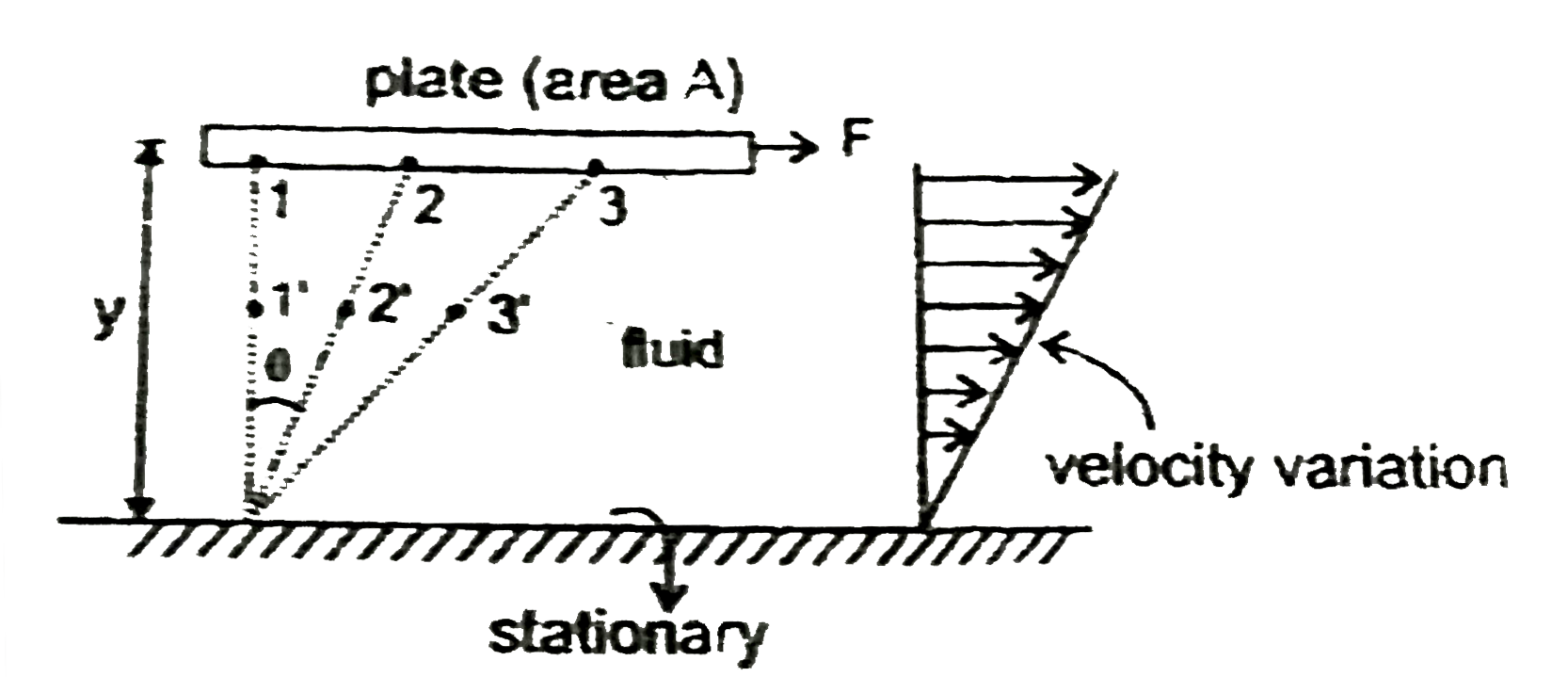
In the given figure as the the plate moves the fluid particle at the surface moves from position 1 to 2 and so on, but particles at the bottom boundry remain stationary. if the gap between palte and bottom boundary is small, fluid particles in between plate and bottom moves with velocities as shown by linear velocity distribution curve otherwise the velocity distribution may be parabolic. As per Newton's law of viscity the tangential force is related to time rate of deformation -
FAαd'θdt but y=d'θdt=u,d'θdt=uy
then F=ηAuy,η= coefficient of viscosity
for non-linear velocity distribution -
F=ηAdudy
where uy or dudy is known as velocity gradiant.
The velocity gradient just below the plate, in above problem is equal to - (per second)
View SolutionViscosity is the property of fluid by virtue of which fluid offers resistance to deformation under the influence of a tangential force.
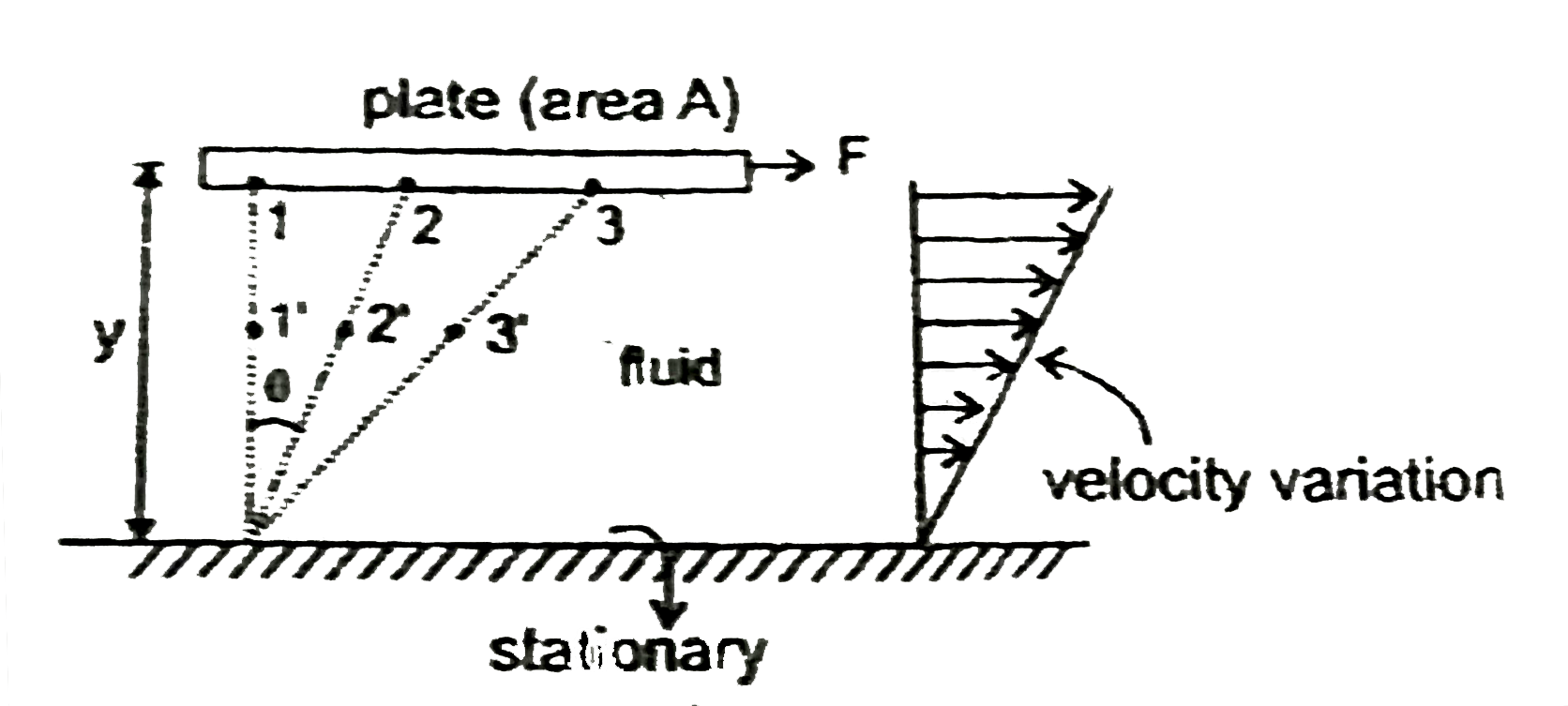
In the given figure as the the plate moves the fluid particle at the surface moves from position 1 to 2 and so on, but particles at the bottom boundry remain stationary. if the gap between palte and bottom boundary is small, fluid particles in between plate and bottom moves with velocities as shown by linear velocity distribution curve otherwise the velocity distribution may be parabolic. As per Newton's law of viscity the tangential force is related to time rate of deformation -
FAαd'θdt but y=d'θdt=u,d'θdt=uy
then F=ηAuy,η= coefficient of viscosity
for non-linear velocity distribution -
F=ηAdudy
where uy or dudy is known as velocity gradiant.
If velocity distribution is given as (parabolic)
u=c1y2+c2y+c3
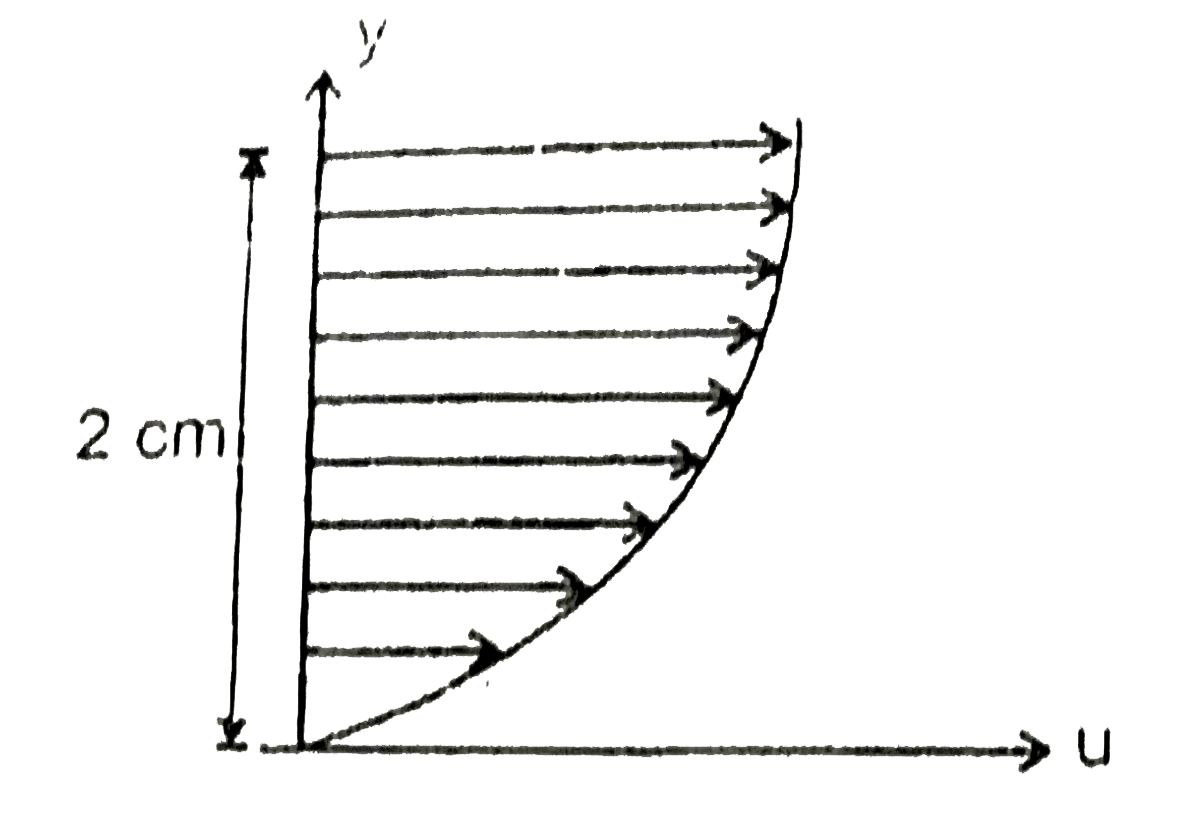 For the same force of 2N and the speed of the plate 2m/sec, and area of plate is 1 and viscousity is .001, the constant C1,C2 & C3 are
For the same force of 2N and the speed of the plate 2m/sec, and area of plate is 1 and viscousity is .001, the constant C1,C2 & C3 are
View SolutionViscosity is the property of fluid by virtue of which fluid offers resistance to deformation under the influence of a tangential force.
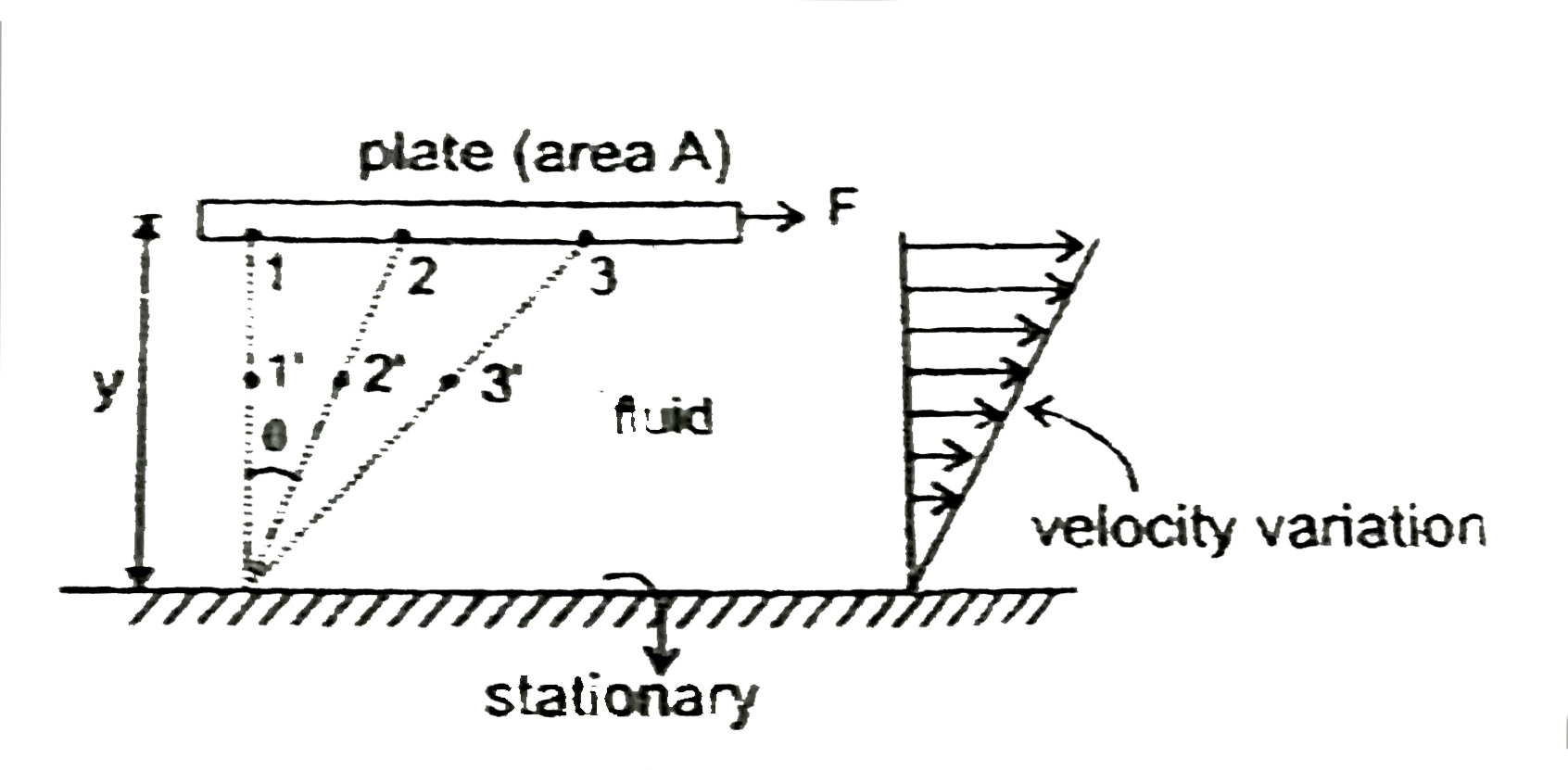
In the given figure as the the plate moves the fluid particle at the surface moves from position 1 to 2 and so on, but particles at the bottom boundry remain stationary. if the gap between palte and bottom boundary is small, fluid particles in between plate and bottom moves with velocities as shown by linear velocity distribution curve otherwise the velocity distribution may be parabolic. As per Newton's law of viscity the tangential force is related to time rate of deformation -
FAαd'θdt but y=d'θdt=u,d'θdt=uy
then F=ηAuy,η= coefficient of viscosity
for non-linear velocity distribution -
F=ηAdudy
where uy or dudy is known as velocity gradiant.
In the given figure if force of 2N required to maintain constant velocity of plate, the value of constant C1,&C2 are -
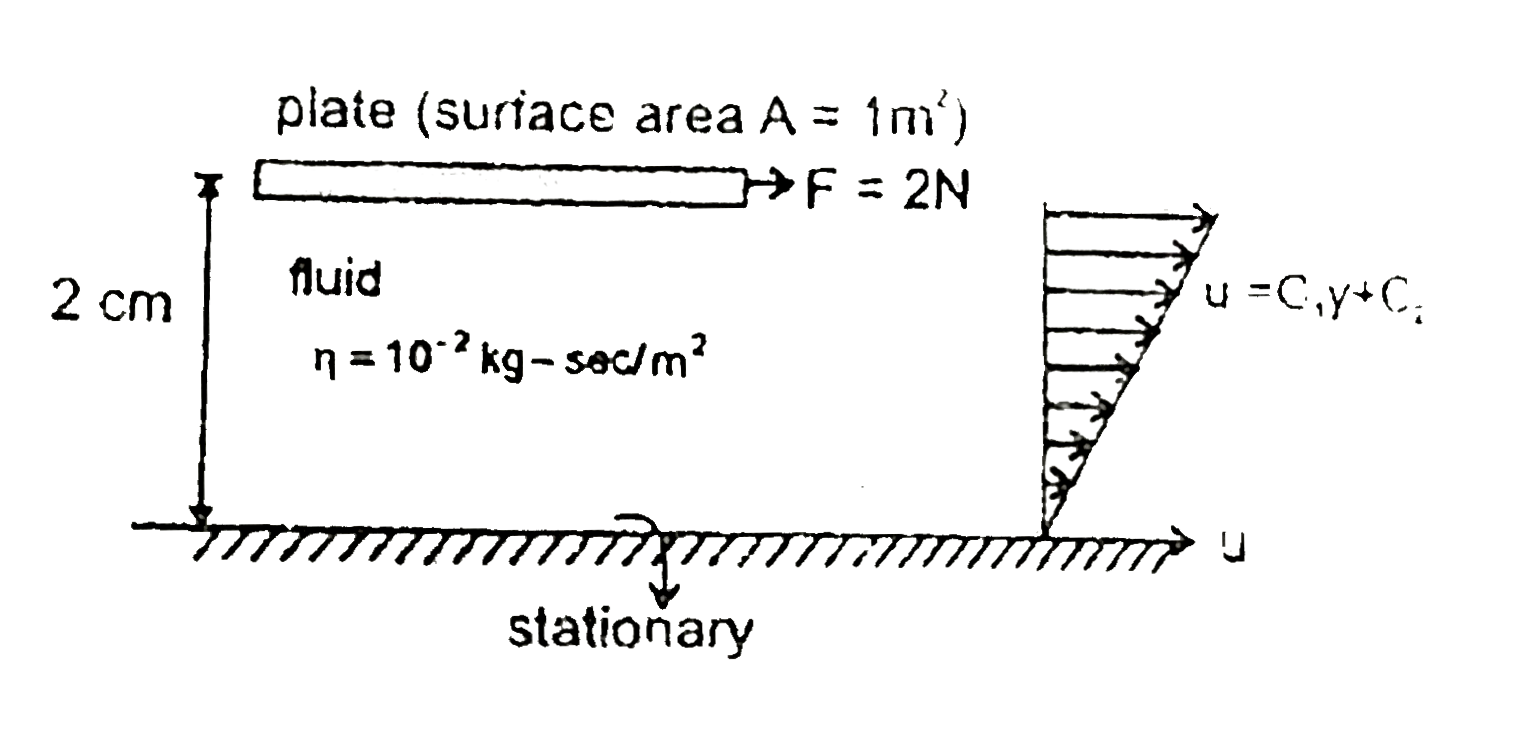
View SolutionWho discovered that phototropism is the result of presence of more auxin on shaded side than on illuminated side.
View SolutionA body executes SHM under the influence of one force and has a period T1 seconds and the same body executes SHM with period T2 seconds when under the influence of another force. When both forces act simultaneously and in the same direction, then the time period of the same body (in seconds) is:
View Solution
